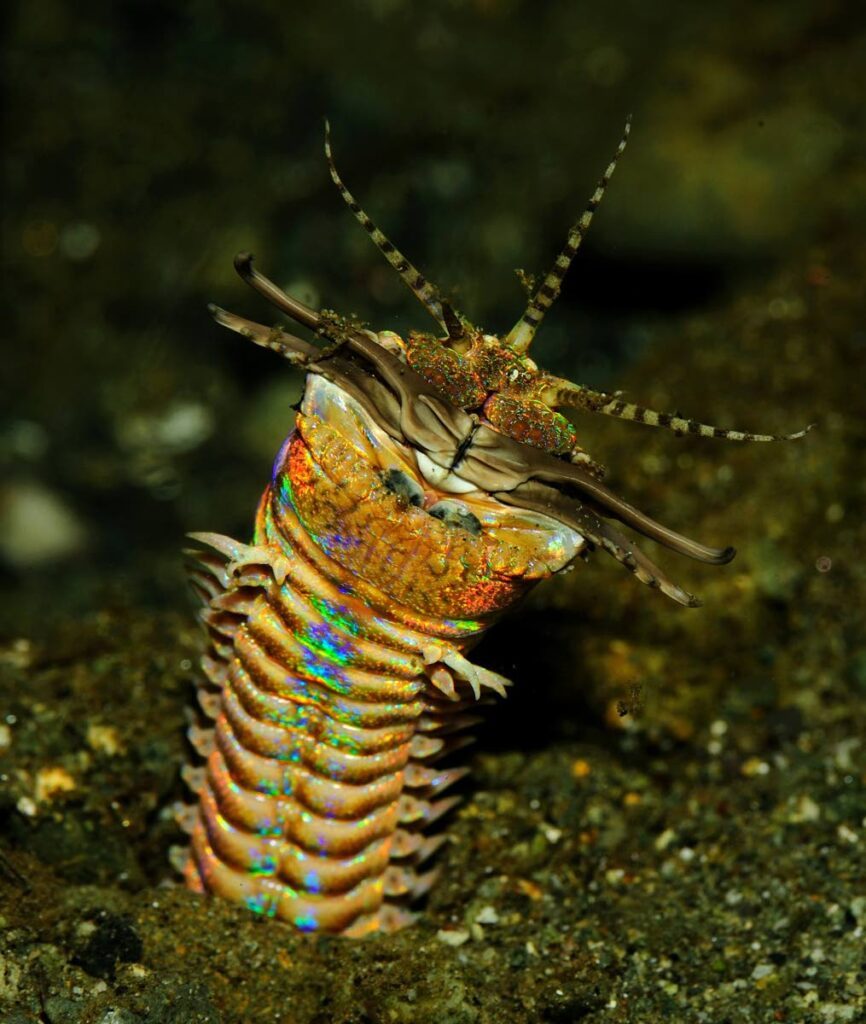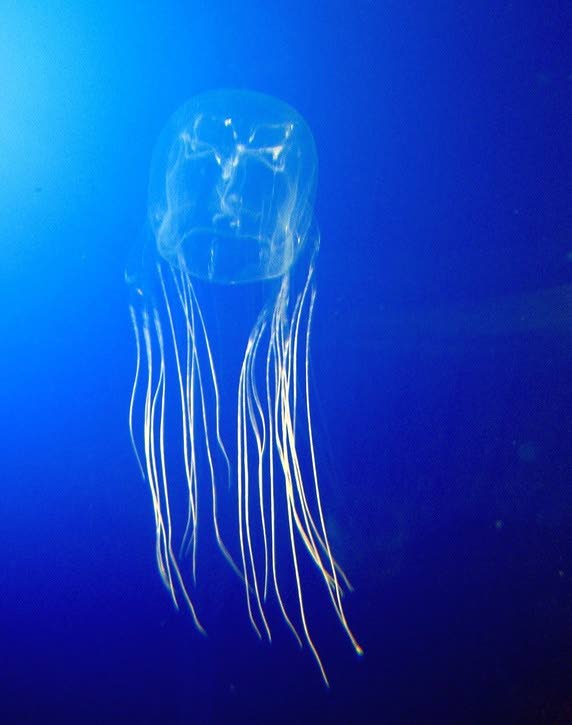Undersea creatures of nightmare

Dr Anjani Ganase presents some marine creatures that have terrifying defence mechanisms. Fortunately, most of them are small and only make themselves visible when threatened. Look closely and maybe you’ll see which ones inspired monsters of fiction and film.
Slice-and-dice jaws
What buries itself in the sand, lying completely still in order to grab and pull an unsuspecting prey away into the underworld of coral reefs? The Bobbit worm invokes depictions of the sand monsters of sci-fi movies, such as Dune and Tremors. In real life, this worm is only a few inches wide but can grow up to ten feet in length. Its razor-sharp jaws can chop a small fish into pieces. It was named after Lorena Bobbitt, who severed her husband’s private parts. If that wasn’t enough, the worm also injects venom into its prey.
The name Bobbit worm is actually used to describe least 50 species of predatory worms with similar behaviour, since the specimen collected could not be identified to species.

The Bobbit worm occurs in the tropical shallow reefs of the Indo-Pacific and only poses a threat to small fish and crustaceans that live along the reef’s sandy bottom. Its antennae can detect small vibrations in the water above. However, some fish species can fight back; if the Bobbit worm’s hiding place is found, fish can blow jets of waters on the sand to force it out of hiding.
Trapdoors for the unsuspecting
Tunicates represent a group of marine invertebrates that resemble sea squirts or salps. They are typically attached to surfaces, have a rubbery appearance and two tubes for siphoning water for filter feeding. The predatory tunicate (Megalodicopia hians) occurs along the walls of deep-sea canyons in the temperate and polar Pacific Ocean around 5,500 metres down. They stand around five inches in height and stick out into the darkness. The predatory tunicates are known as the Venus flytraps of the deep sea: they wait opened-mouthed for tiny fish or crustaceans (zooplankton) to swim past the cavernous mouth so that it can close around it.

Turning their prey into zombies
Deadly things come in small sizes, especially in the ocean, where over 90 per cent of the ocean life is composed of micro-organisms. Phrominas are predatory marine amphipods (shrimp-like in appearance) that resembles the queen alien from the 1986 movie Alien. Phrominas kill gelatinous plankton, such as salps (barrel-shaped planktonic tunicate) by eating out their insides, living in their hollowed-out bodies and laying eggs. The tissue of the salp barrel stays alive for a while, and retains its shape. The salp barrel gives the phronima a stable home that is buoyant and makes it easy to move around with its egg safe from the exposed environment. They typically hunt in the twilight zone (low-light depths) of the ocean and can make themselves invisible to predators and prey with specialised pigments. They are common in the temperate and tropical oceans.
Toxic tentacles
The Australian box jelly (Chironex fleckeri) is an extremely venomous species of jellyfish found around Australia and the Indo-Pacific. Its venom is known to cause crippling pain and death. During the spring period of Australia (September-October), these box jellies which typically occur in nearshore marine environments, swim up rivers and gather for spawning. While the adults die after spawning, newborns are carried out to sea by the river flow.

Box jellies are very capable swimmers, able to swim against currents. They hunt small fish and shrimp by using their stinging cells to capture and kill prey. The only known predator of the box jellies is the green turtles, which have a thick skin that is impenetrable to the stinging cells.
They are very dangerous to humans. It is estimated that if six metres of box-jelly tentacles come into contact with a human and all the stinging cells fire off, this will cause death in a few minutes. The
Chironex species can have tentacles up to three metres long. While the typical exposure is a mere fraction of this, victims experience pain, shortness of breath, and even cardiac arrest. Symptoms may last for weeks.
Most of the deaths from victims of the Australian box jelly are children and young adults. This is why stinger nets and stinger suits are recommended in tropical and sub-tropical areas of Australia, especially near river mouths during the spring and summer periods.
Blue rings for danger
Being venomous in the ocean almost comes with the territory when defending oneself in the busy benthic environment.

Bright rings are displayed by the blue-ringed octopus when threatened; these should be fair warning to potential predators. This tiny cephalopod (only 12 cm long, including its arms) houses a deadly chemical that runs throughout its body and is made of a chemical called tetrodotoxin or TTX. The chemical is produced by symbiotic bacteria housed in its salivary glands.
The toxin is used for hunting as well as for defence. TTX is a neurotoxin that causes muscle paralysis that eventually results in respiratory failure. The toxin is 1,000 times more potent than cyanide and is the same toxin found in pufferfish. There is no antidote.
There are ten species of blue-ringed octopuses that occupy mainly coral reefs in the Indo-Pacific, and species that occupy deeper waters along Australia’s south coast and Tasmania. Incidents of humans being affected by blue-ringed octopuses are largely underheard of except for the one case where a person consumed it.

Comments
"Undersea creatures of nightmare"